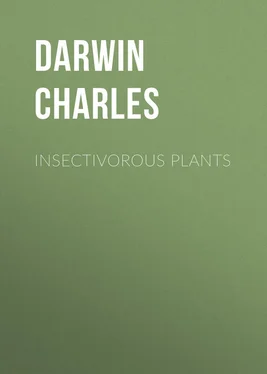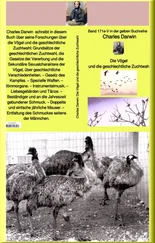Charles Darwin - Insectivorous Plants
Здесь есть возможность читать онлайн «Charles Darwin - Insectivorous Plants» — ознакомительный отрывок электронной книги совершенно бесплатно, а после прочтения отрывка купить полную версию. В некоторых случаях можно слушать аудио, скачать через торрент в формате fb2 и присутствует краткое содержание. Жанр: foreign_antique, foreign_prose, на английском языке. Описание произведения, (предисловие) а так же отзывы посетителей доступны на портале библиотеки ЛибКат.
- Название:Insectivorous Plants
- Автор:
- Жанр:
- Год:неизвестен
- ISBN:нет данных
- Рейтинг книги:5 / 5. Голосов: 1
-
Избранное:Добавить в избранное
- Отзывы:
-
Ваша оценка:
- 100
- 1
- 2
- 3
- 4
- 5
Insectivorous Plants: краткое содержание, описание и аннотация
Предлагаем к чтению аннотацию, описание, краткое содержание или предисловие (зависит от того, что написал сам автор книги «Insectivorous Plants»). Если вы не нашли необходимую информацию о книге — напишите в комментариях, мы постараемся отыскать её.
Insectivorous Plants — читать онлайн ознакомительный отрывок
Ниже представлен текст книги, разбитый по страницам. Система сохранения места последней прочитанной страницы, позволяет с удобством читать онлайн бесплатно книгу «Insectivorous Plants», без необходимости каждый раз заново искать на чём Вы остановились. Поставьте закладку, и сможете в любой момент перейти на страницу, на которой закончили чтение.
Интервал:
Закладка:
Experiment 11. – A leaf was immersed in water at 145o (62o.7 Cent.), which was raised to 156o (68o.8 Cent.). The tentacles became bright red and somewhat reflexed, with almost all the glands like porcelain; those on the disc being still pinkish, those near the margin quite white. The leaf being placed as usual first in cold water and then in the strong solution, the cells in the tentacles became of a muddy greenish brown, with the protoplasm not aggregated. Nevertheless, four of the glands escaped being rendered like porcelain, and the pedicels of these glands were spirally curled, like a French horn, towards their upper ends; but this can by no means be considered as a case of true inflection. The protoplasm within the cells of the twisted portions was aggregated into distinct though excessively minute purple spheres. This case shows clearly that the protoplasm, after having been exposed to a high temperature for a few minutes, is capable of aggregation when afterwards subjected to the action of carbonate of ammonia, unless the heat has been sufficient to cause coagulation.]
Concluding Remarks. – As the hair-like tentacles are extremely thin and have delicate walls, and as the leaves were waved about for some minutes close to the bulb of the thermometer, it seems scarcely possible that they should not have been raised very nearly to the temperature which the instrument indicated. From the eleven last observations we see that a temperature of 130o (54o.4 Cent.) never causes the immediate inflection of the tentacles, though a temperature from 120o to 125o (48o.8 to 51o.6 Cent.) quickly produces this effect. But the leaves are paralysed only for a time by a temperature of 130o, as afterwards, whether left in simple water or in a solution of carbonate of ammonia, they become inflected and their protoplasm undergoes aggregation. This great difference in the effects of a higher and lower temperature may be compared with that from immersion in strong and weak solutions of the salts of ammonia; for the former do not excite movement, whereas the latter act energetically. A temporary suspension of the power of movement due to heat is called by Sachs 13 13 'Trait de Bot.' 1874, p. 1034.
heat-rigidity; and this in the case of the sensitive-plant (Mimosa) is induced by its exposure for a few minutes to humid air, raised to 120o-122o Fahr., or 49o to 50 °Cent. It deserves notice that the leaves of Drosera, after being immersed in water at 130o Fahr., are excited into movement by a solution of the carbonate so strong that it would paralyse ordinary leaves and cause no inflection.
The exposure of the leaves for a few minutes even to a temperature of 145o Fahr. (62o.7 Cent.) does not always kill them; as when afterwards left in cold water, or in a strong solution of carbonate of ammonia, they generally, though not always, become inflected; and the protoplasm within their cells undergoes aggregation, though the spheres thus formed are extremely small, with many of the cells partly filled with brownish muddy matter. In two instances, when leaves were immersed in water, at a lower temperature than 130o (54o.4 Cent.), which was then raised to 145o (62o.7 Cent.), they became during the earlier period of immersion inflected, but on being afterwards left in cold water were incapable of re-expansion. Exposure for a few minutes to a temperature of 145o sometimes causes some few of the more sensitive glands to be speckled with the porcelain-like appearance; and on one occasion this occurred at a temperature of 140o (60 °Cent.). On another occasion, when a leaf was placed in water at this temperature of only 140o, and left therein till the water cooled, every gland became like porcelain. Exposure for a few minutes to a temperature of 150o (65o.5 Cent.) generally produces this effect, yet many glands retain a pinkish colour, and many present a speckled appearance. This high temperature never causes true inflection; on the contrary, the tentacles commonly become reflexed, though to a less degree than when immersed in boiling water; and this apparently is due to their passive power of elasticity. After exposure to a temperature of 150o Fahr., the protoplasm, if subsequently subjected to carbonate of ammonia, instead of undergoing aggregation, is converted into disintegrated or pulpy discoloured matter. In short, the leaves are generally killed by this degree of heat; but owing to differences of age or constitution, they vary somewhat in this respect. In one anomalous case, four out of the many glands on a leaf, which had been immersed in water raised to 156o (68o.8 Cent.), escaped being rendered porcellanous; 14 14 As the opacity and porcelain-like appearance of the glands is probably due to the coagulation of the albumen, I may add, on the authority of Dr. Burdon Sanderson, that albumen coagulates at about 155o, but, in presence of acids, the temperature of coagulation is lower. The leaves of Drosera contain an acid, and perhaps a difference in the amount contained may account for the slight differences in the results above recorded. It appears that cold-blooded animals are, as might have been expected, far more sensitive to an increase of temperature than is Drosera. Thus, as I hear from Dr. Burdon Sanderson, a frog begins to be distressed in water at a temperature of only 85o Fahr. At 95o the muscles become rigid, and the animal dies in a stiffened condition.
and the protoplasm in the cells close beneath these glands underwent some slight, though imperfect, degree of aggregation.
Finally, it is a remarkable fact that the leaves of Drosera rotundifolia, which flourishes on bleak upland moors throughout Great Britain, and exists (Hooker) within the Arctic Circle, should be able to withstand for even a short time immersion in water heated to a temperature of 145o.
It may be worth adding that immersion in cold water does not cause any inflection: I suddenly placed four leaves, taken from plants which had been kept for several days at a high temperature, generally about 75o Fahr. (23o.8 Cent.), in water at 45o (7o.2 Cent.), but they were hardly at all affected; not so much as some other leaves from the same plants, which were at the same time immersed in water at 75o; for these became in a slight degree inflected.
CHAPTER V
Non-nitrogenous fluids – Solutions of gum arabic – Sugar – Starch – Diluted alcohol – Olive oil – Infusion and decoction of tea – Nitrogenous fluids – Milk – Urine – Liquid albumen – Infusion of raw meat – Impure mucus – Saliva – Solution of isinglass – Difference in the action of these two sets of fluids – Decoction of green peas – Decoction and infusion of cabbage – Decoction of grass leaves.
WHEN, in 1860, I first observed Drosera, and was led to believe that the leaves absorbed nutritious matter from the insects which they captured, it seemed to me a good plan to make some preliminary trials with a few common fluids, containing and not containing nitrogenous matter; and the results are worth giving.
In all the following cases a drop was allowed to fall from the same pointed instrument on the centre of the leaf; and by repeated trials one of these drops was ascertained to be on an average very nearly half a minim, or 1/960 of a fluid ounce, or .0295 ml. But these measurements obviously do not pretend to any strict accuracy; moreover, the drops of the viscid fluids were plainly larger than those of water. Only one leaf on the same plant was tried, and the plants were collected from two distant localities. The experiments were made during August and September. In judging of the effects, one caution is necessary: if a drop of any adhesive fluid is placed on an old or feeble leaf, the glands of which have ceased to secrete copiously, the drop sometimes dries up, especially if the plant is kept in a room, and some of the central and submarginal tentacles are thus drawn together, giving to them the false appearance of having become inflected. This sometimes occurs with water, as it is rendered adhesive by mingling with the viscid secretion. Hence the only safe criterion, and to this alone I have trusted, is the bending inwards of the exterior tentacles, which have not been touched by the fluid, or at most only at their bases. In this case the movement is wholly due to the central glands having been stimulated by the fluid, and transmitting a motor impulse to the exterior tentacles. The blade of the leaf likewise often curves inwards, in the same manner as when an insect or bit of meat is placed on the disc. This latter movement is never caused, as far as I have seen, by the mere drying up of an adhesive fluid and the consequent drawing together of the tentacles.
Читать дальшеИнтервал:
Закладка:
Похожие книги на «Insectivorous Plants»
Представляем Вашему вниманию похожие книги на «Insectivorous Plants» списком для выбора. Мы отобрали схожую по названию и смыслу литературу в надежде предоставить читателям больше вариантов отыскать новые, интересные, ещё непрочитанные произведения.
Обсуждение, отзывы о книге «Insectivorous Plants» и просто собственные мнения читателей. Оставьте ваши комментарии, напишите, что Вы думаете о произведении, его смысле или главных героях. Укажите что конкретно понравилось, а что нет, и почему Вы так считаете.












